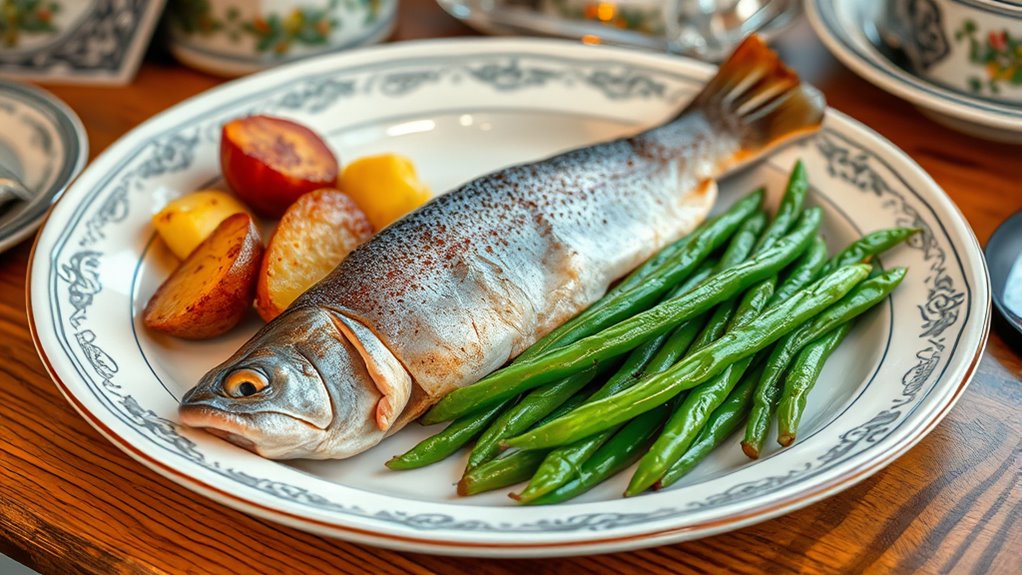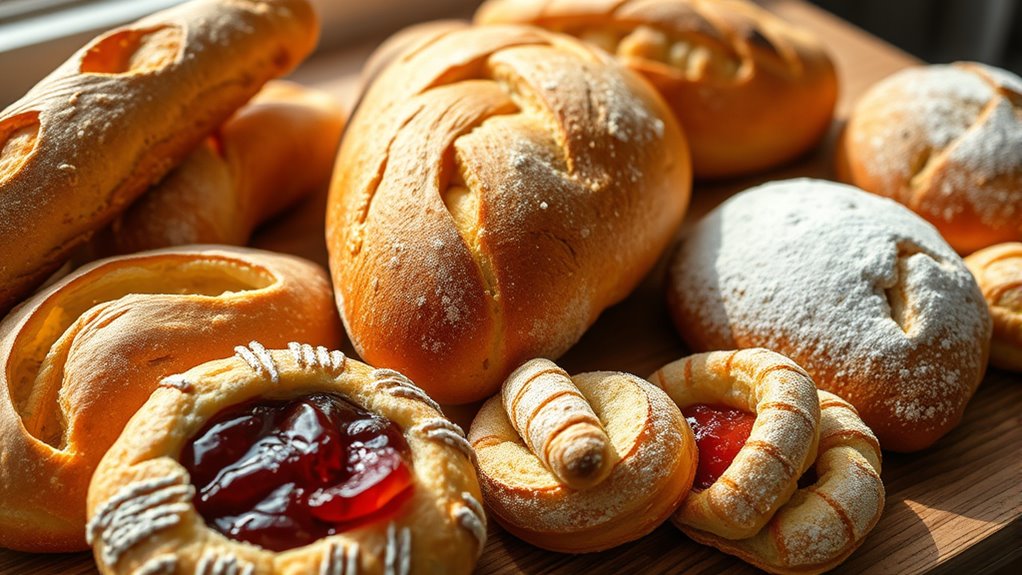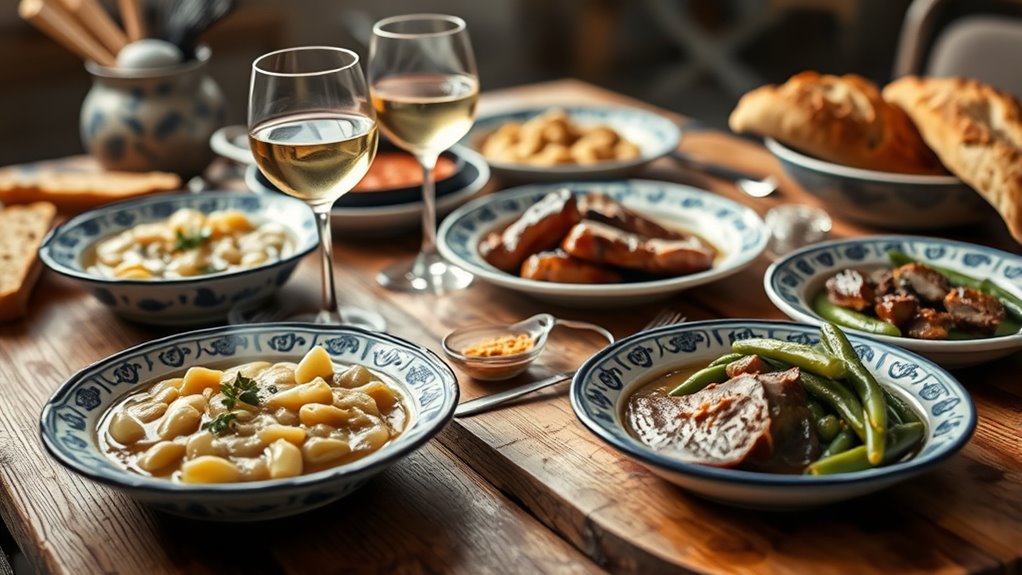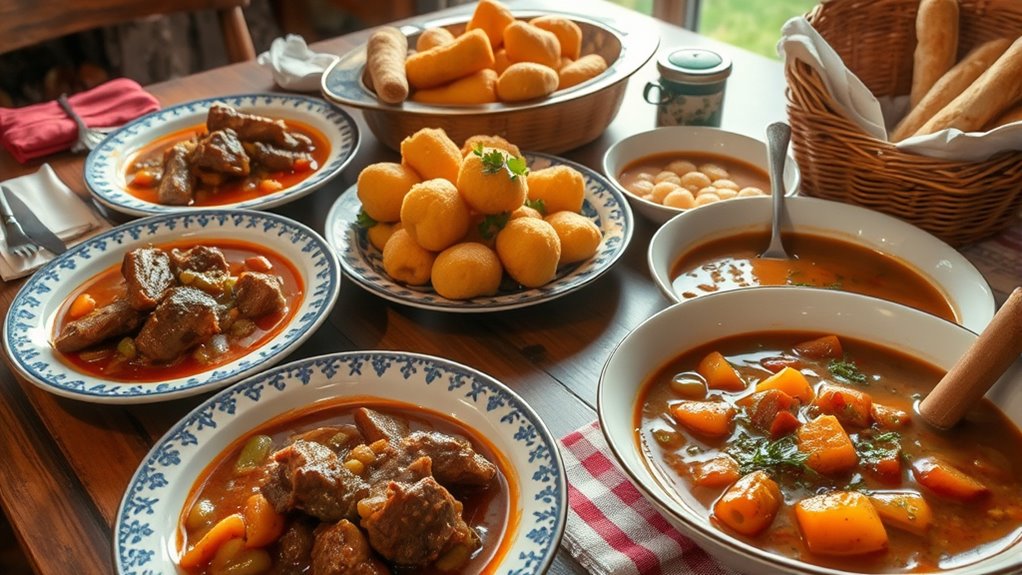Luxembourg’s cuisine blends French elegance, German robustness, and Belgian comfort, rooted in local ingredients like river fish, game, and seasonal produce. You’ll find signature dishes such as smoked pork with broad beans, hearty sausages, fish from the Moselle River, and potato fritters. Breads, pastries, and regional cheeses enrich the meals, while influences from Portugal and neighboring countries add flavor. To discover the full story behind Luxembourg’s culinary heritage, explore further.
Key Takeaways
- Luxembourg’s cuisine blends French elegance, German robustness, and Belgian comfort, emphasizing local ingredients like river fish, wild game, and seasonal produce.
- Signature dishes include smoked pork with broad beans, potato fritters, blood sausage, and regional specialties like jugged hare.
- Traditional cooking techniques focus on preservation, regional flavors, and sustainable practices with seasonal and regional ingredients.
- Breads, pastries, and dairy products such as pretzels, apple-filled pastries, and regional cheeses are integral to cultural culinary traditions.
- Modern innovations incorporate fusion, sustainable sourcing, and international influences, enriching Luxembourg’s evolving culinary scene.
National and Signature Dishes of Luxembourg

Luxembourg’s culinary identity is best represented by its national and signature dishes, which showcase a rich blend of local ingredients and cultural influences. Judd mat Gaardebounen stands out as the national dish, featuring smoked pork collar served with horseradish-flavored broad beans and boiled potatoes. Kuddelfleck, crispy fried beef tripe, reflects the country’s nose-to-tail eating tradition. Bouneschlupp, a hearty green bean and potato soup with bacon, offers winter comfort. Traïpen, a rustic blood sausage, highlights regional herbs and traditional methods. Wäinzoossiss, marinated pork sausages, remain a popular local favorite. These dishes reveal Luxembourg’s love for simple, hearty flavors rooted in local produce, traditional techniques, and a multicultural culinary heritage. Practicing changing gears can help you better appreciate the diverse techniques used in preparing these hearty dishes.
Meat and Fish Specialties in Luxembourg Cuisine

Meat and fish play a pivotal role in Luxembourgish cuisine, showcasing both the country’s rich agricultural traditions and its proximity to rivers and forests. You’ll find hearty dishes like Judd mat Gaardebounen, featuring smoked pork collar served with broad beans and potatoes, considered the national dish. For offal lovers, Kuddelfleck offers crispy fried beef tripe with spicy tomato sauce. Fish specialties highlight local rivers, such as F’rell am Rèisleck—trout cooked in Riesling sauce—and Friture de la Moselle, small fried fish from the Moselle River served with regional white wine. You might also enjoy Huesenziwwi, jugged hare, especially during hunting season. These dishes reflect Luxembourg’s appreciation for traditional, locally sourced ingredients, celebrating its culinary heritage through robust meat and fish flavors. Additionally, some traditional methods for preparing these dishes have been preserved through culinary traditions, ensuring that authentic flavors remain an integral part of Luxembourg’s gastronomy.
Traditional Potatoes and Vegetable Dishes

You’ll find that classic potato fritters are a beloved street food, crispy and flavorful with onions and parsley. Hearty vegetable soups, like Bouneschlupp, use fresh Luxembourgish produce to warm you during winter. Rustic potato salads, such as Flintstone salad, showcase simple yet hearty preparations rooted in tradition. Additionally, traditional toys and utensils made from natural materials are often used in preparing and serving these dishes, reflecting the importance of eco-friendly choices in Luxembourgish culinary heritage.
Classic Potato Fritters
Classic potato fritters, known locally as Gromperekichelcher, are a beloved staple of Luxembourgish cuisine. You’ll find them crispy on the outside and tender inside, often flavored with onions, parsley, and sometimes bacon. They’re commonly enjoyed as street food or at family gatherings, especially during festivals and markets. To make them, you grate potatoes, squeeze out excess moisture, and mix in herbs and seasoning. You then form small patties and fry until golden brown. These fritters highlight Luxembourg’s love for simple, hearty ingredients prepared with care. They pair well with apple sauce, mustard, or just a sprinkle of salt. Whether served as a snack or part of a larger meal, Gromperekichelcher embodies the rustic, flavorful spirit of Luxembourg’s traditional cooking. Incorporating traditional culinary techniques can also enhance their texture and flavor.
Hearty Vegetable Soups
Hearty vegetable soups are a staple in Luxembourgish cuisine, especially during the cold winter months. You’ll find them comforting and simple, often made with seasonal ingredients. Here are four key aspects:
- They usually feature locally grown vegetables like carrots, leeks, and cabbage.
- Bacon or smoked meats add smoky depth and richness.
- Potatoes frequently thicken the broth, creating a hearty texture.
- Traditional recipes are straightforward, highlighting the natural flavors of fresh produce.
- These soups often include seasonal ingredients that reflect Luxembourg’s agricultural practices and regional availability.
These soups serve as warming, nourishing meals that reflect Luxembourg’s rustic culinary roots. Whether enjoyed as a main course or starter, they embody the country’s love for fresh, seasonal ingredients combined with robust, comforting flavors.
Rustic Potato Salads
Rustic potato salads hold a special place in Luxembourgish cuisine, embodying the country’s love for simple, hearty dishes that highlight fresh, local ingredients. These salads typically feature boiled potatoes mixed with onions, herbs, and a tangy vinaigrette or creamy dressing. They’re versatile, served as sides or main dishes, especially during family gatherings and festivals. The preparation emphasizes rustic flavors and straightforward techniques, reflecting Luxembourg’s rural roots. To deepen your understanding, here’s a quick overview:
| Ingredient | Preparation Method | Serving Style |
|---|---|---|
| Potatoes | Boiled, sliced | Cold or warm |
| Onions | Chopped | Raw or pickled |
| Herbs | Fresh, chopped | As garnish |
| Vinaigrette | Mustard, vinegar, oil | Drizzled on top |
| Additional Veg | Carrots, beans | Mixed or side dish |
Additionally, the use of color accuracy in preparing and presenting these salads can enhance their visual appeal, making them more appetizing and vibrant.
Breads, Pastries, and Sweet Treats

Luxembourg’s breads and pastries reflect a rich culinary heritage rooted in tradition and local ingredients. You’ll find simple yet flavorful baked goods that have stood the test of time. Here are some highlights:
- Pretzels: A Lenten favorite, enjoyed during religious festivals with a distinctive twist from the German version.
- Quetschentaart: Autumn’s delight, this plum tart uses zwetschgen plums for a sweet, tangy flavor.
- Verwurelt Gedanken: Festive small doughnuts dusted with powdered sugar, perfect for celebrations.
- Äppelklatzen: Apples en croûte, a pastry filled with fruit, showcasing Luxembourg’s love for baked sweets.
Adding to the cultural richness, these traditional treats also foster self-awareness by connecting bakers and families to their heritage through shared culinary practices.
Cheese and Dairy Products in Luxembourg

Cheese and dairy products play an essential role in Luxembourg’s culinary tradition, offering a rich array of flavors and textures that complement many local dishes. You’ll find Kachkéis, a soft, spreadable cheese often melted on bread with mustard, serving as a staple. Local white cheeses are common, enjoyed with fresh bread or mixed into sauces and spreads. Creamy sauces, made with local dairy, frequently accompany meat and fish, highlighting the dairy-rich agricultural heritage. Cheese toast adds richness to vegetable dishes like Öennenzop, and dairy features prominently in baking, with cream and butter used in pastries and desserts. These dairy products not only enhance flavors but also reflect Luxembourg’s traditional reliance on regional, high-quality ingredients. The use of butter in traditional recipes has evolved over centuries, influenced by production techniques and innovations, ensuring both preservation and enhancement of flavors.
Cultural Influences and Evolution of Local Gastronomy

You can see how Luxembourg’s cuisine reflects a blend of French, German, and Belgian influences, shaping traditional dishes and cooking styles. Over time, these traditions have adapted to modern tastes while honoring their roots, creating a unique culinary fusion. This evolution highlights how local food continues to balance tradition and innovation, keeping Luxembourg’s gastronomy vibrant. Additionally, the incorporation of local ingredients and innovative cooking techniques demonstrates the dynamic nature of its culinary scene.
Regional Culinary Fusion
The culinary landscape of Luxembourg has evolved through a dynamic fusion of neighboring influences, shaping a unique gastronomic identity. You’ll notice how French elegance melds with hearty German traditions and Belgian comfort foods, creating a diverse flavor profile. Here’s what you’ll find:
- French techniques elevate dishes like pâtés and pastries, adding sophistication.
- German-style sausages and hearty stews reflect regional robustness.
- Belgian-influenced chocolates and waffles appear in local desserts.
- Portuguese flavors, especially bacalhau, have become integrated since the 1960s.
- Incorporating traditional textiles in presentation and decor can enhance the authentic culinary experience.
This blend results in a cuisine that’s both rustic and refined. Local ingredients like river fish, wild game, and seasonal produce serve as a common thread, tying these influences into a distinctive Luxembourgish culinary tapestry.
Tradition Meets Modernity
As Luxembourg’s culinary scene evolves, traditional dishes seamlessly blend with modern techniques and international influences, creating a vibrant and dynamic gastronomy. You’ll notice how chefs reinterpret classics like Judd mat Gaardebounen or Gromperekichelcher with contemporary plating and innovative ingredients, adding fresh twists while honoring tradition. French, German, and Belgian influences continue to shape the menu, but new culinary trends emphasize seasonal, local sourcing and sustainable practices. Portuguese bacalhau dishes have become staples, reflecting migration and cultural exchange. Modern gastronomy also explores fusion cuisines and molecular techniques, making familiar flavors more exciting. This evolution allows you to experience Luxembourg’s rich culinary heritage in fresh, inventive ways, bridging the past and present with creativity and respect for local roots.
Frequently Asked Questions
What Are Luxembourg’s Most Popular Street Foods?
You’ll find that Luxembourg’s most popular street foods include Gromperekichelcher, crispy potato fritters flavored with onions and parsley, perfect for snacking. You might also enjoy pretzels, especially during Lent and religious holidays. Additionally, kniddelen, thick dumplings served with cream and bacon, are a hearty choice. These foods reflect local flavors and traditions, making them a delicious way to experience Luxembourg’s vibrant street food scene.
How Does Luxembourg Incorporate Seasonal and Regional Ingredients?
You’ll notice Luxembourg incorporates seasonal and regional ingredients by focusing on local produce, river fish, and wild game. In winter, hearty soups like Bouneschlupp highlight fresh vegetables and potatoes. During hunting season, dishes with game meats like Huesenziwwi become popular. You’ll also find regional cheeses, fresh herbs, and local wines used in cooking, ensuring that each dish celebrates Luxembourg’s agricultural and natural bounty throughout the year.
Are There Any Unique Luxembourgish Culinary Festivals or Events?
You’ll find Luxembourg hosts vibrant culinary festivals celebrating local flavors, regional traditions, and seasonal bounty. The annual Gromperekichelcher Festival highlights the beloved potato fritters, while the Wine and Food Festival showcases local wines paired with regional dishes. The National Day festivities feature traditional food stalls, and harvest festivals honor seasonal produce like plums and apples. These events invite you to taste, celebrate, and immerse yourself in Luxembourg’s rich gastronomic culture.
How Has Luxembourg’s Cuisine Evolved With Modern Gastronomy Trends?
Luxembourg’s cuisine has evolved by blending traditional flavors with modern gastronomy trends. You’ll find chefs reinterpreting classic dishes like Judd mat Gaardebounen with innovative techniques and presentation. They incorporate seasonal, local ingredients and embrace international influences, such as French, German, and Portuguese flavors. You’re encouraged to explore contemporary restaurants that elevate traditional recipes, making Luxembourgish food more diverse, refined, and appealing to global palates while respecting its culinary roots.
What Traditional Beverages Are Typically Enjoyed With Local Dishes?
You’re likely to savor a glass of crisp Riesling or locally brewed beer, their bubbles and flavors teasing your senses. Imagine the rich aroma of Luxembourgish wine pairing perfectly with hearty pork or fish dishes, heightening every bite. Or picture clinking glasses of invigorating beer during festive gatherings, adding a lively touch. These beverages weave tradition into your meal, making every bite a celebration of Luxembourg’s vibrant, flavorful culinary heritage.
Conclusion
As you immerse yourself in Luxembourg’s culinary world, you’ll discover a tapestry so rich and vibrant, it could rival the most legendary feasts of history. From hearty meat dishes to delicate pastries, every bite promises an explosion of flavors that will elevate your palate to new heights. Embrace the cultural mosaic woven into each recipe, and you’ll find yourself enchanted by a gastronomy so extraordinary, it might just redefine your very idea of fine cuisine.










